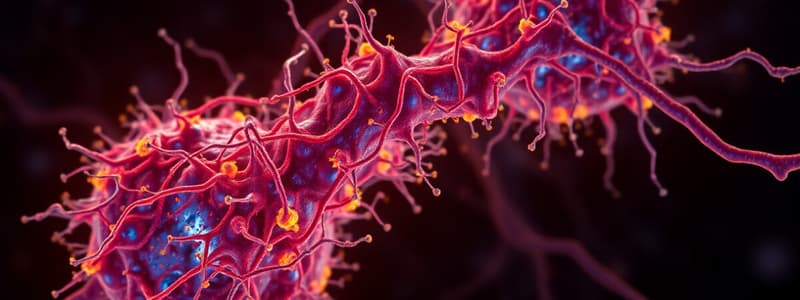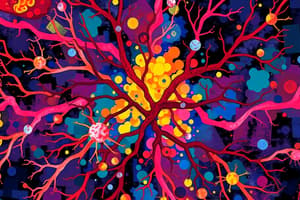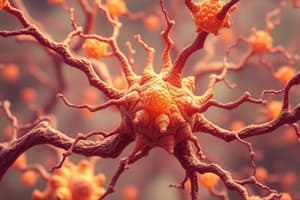Podcast
Questions and Answers
Which of the following molecules are important for excitatory synaptic signaling?
Which of the following molecules are important for excitatory synaptic signaling?
What is the time scale at which responses and signals operate in the nervous system?
What is the time scale at which responses and signals operate in the nervous system?
Which of the following is NOT considered a major disease associated with molecular neuroscience?
Which of the following is NOT considered a major disease associated with molecular neuroscience?
In molecular neuroscience research, which technique is commonly used to study gene expression?
In molecular neuroscience research, which technique is commonly used to study gene expression?
Signup and view all the answers
What is the approximate number of neurons in the human brain?
What is the approximate number of neurons in the human brain?
Signup and view all the answers
Which of the following statements about protein function in the brain is false?
Which of the following statements about protein function in the brain is false?
Signup and view all the answers
Which of the following processes does NOT involve gene expression regulation?
Which of the following processes does NOT involve gene expression regulation?
Signup and view all the answers
What is the concentration of chloride ions outside the cell?
What is the concentration of chloride ions outside the cell?
Signup and view all the answers
Which type of synapse is characterized by direct electrical flow between cells?
Which type of synapse is characterized by direct electrical flow between cells?
Signup and view all the answers
What is the threshold for activation of sodium channels?
What is the threshold for activation of sodium channels?
Signup and view all the answers
Which process describes the conversion of an electrical signal into a chemical signal?
Which process describes the conversion of an electrical signal into a chemical signal?
Signup and view all the answers
What is the major ion with a higher concentration inside the cell as compared to outside?
What is the major ion with a higher concentration inside the cell as compared to outside?
Signup and view all the answers
What is the primary function of voltage-sensitive protein holes in neurons?
What is the primary function of voltage-sensitive protein holes in neurons?
Signup and view all the answers
What ions do sodium channels primarily select for?
What ions do sodium channels primarily select for?
Signup and view all the answers
How is signal termination achieved in chemical synapses?
How is signal termination achieved in chemical synapses?
Signup and view all the answers
What is the primary orientation of microtubules in the axon compartment?
What is the primary orientation of microtubules in the axon compartment?
Signup and view all the answers
Which cytoskeleton component is primarily responsible for stabilizing axons?
Which cytoskeleton component is primarily responsible for stabilizing axons?
Signup and view all the answers
What is the role of kinesin in neuronal cells?
What is the role of kinesin in neuronal cells?
Signup and view all the answers
In the dendrites, microtubules are arranged in which manner?
In the dendrites, microtubules are arranged in which manner?
Signup and view all the answers
How does kinesin use ATP in its function?
How does kinesin use ATP in its function?
Signup and view all the answers
What is the Na+/K+ ATPase's role in neurons?
What is the Na+/K+ ATPase's role in neurons?
Signup and view all the answers
What molecule is synthesized from glutamate that acts as an inhibitory neurotransmitter?
What molecule is synthesized from glutamate that acts as an inhibitory neurotransmitter?
Signup and view all the answers
What are the terminal regions of dendrites primarily enriched in?
What are the terminal regions of dendrites primarily enriched in?
Signup and view all the answers
Which process ensures that the GAD gene is selectively expressed in GABA neurons?
Which process ensures that the GAD gene is selectively expressed in GABA neurons?
Signup and view all the answers
What type of proteins are involved in forming the complex structure of the cytoskeleton?
What type of proteins are involved in forming the complex structure of the cytoskeleton?
Signup and view all the answers
What is the concentration of sodium outside a neuron compared to inside?
What is the concentration of sodium outside a neuron compared to inside?
Signup and view all the answers
What is the primary role of protein turnover in cells?
What is the primary role of protein turnover in cells?
Signup and view all the answers
Which of the following amino acids acts as an excitatory neurotransmitter?
Which of the following amino acids acts as an excitatory neurotransmitter?
Signup and view all the answers
What is the dynamic structure that gives rise to axons and dendrites in neurons?
What is the dynamic structure that gives rise to axons and dendrites in neurons?
Signup and view all the answers
Which of the following statements about the cytoskeleton's structure is correct?
Which of the following statements about the cytoskeleton's structure is correct?
Signup and view all the answers
What is the role of enhancers and repressors in gene expression for neurotransmitters?
What is the role of enhancers and repressors in gene expression for neurotransmitters?
Signup and view all the answers
What process allows neurotransmitters to be released into the synapse?
What process allows neurotransmitters to be released into the synapse?
Signup and view all the answers
What is the primary role of receptors in synaptic transmission?
What is the primary role of receptors in synaptic transmission?
Signup and view all the answers
Which neurotransmitter is commonly used in major excitatory synapses?
Which neurotransmitter is commonly used in major excitatory synapses?
Signup and view all the answers
What occurs when receptors are activated by neurotransmitters?
What occurs when receptors are activated by neurotransmitters?
Signup and view all the answers
What mechanism helps terminate the chemical signal in a synapse?
What mechanism helps terminate the chemical signal in a synapse?
Signup and view all the answers
Where are major inhibitory synapses typically located?
Where are major inhibitory synapses typically located?
Signup and view all the answers
How are empty vesicles refilled with neurotransmitters?
How are empty vesicles refilled with neurotransmitters?
Signup and view all the answers
What happens to the ion distribution when positive ions flow into the neuron?
What happens to the ion distribution when positive ions flow into the neuron?
Signup and view all the answers
What is a primary characteristic of glutamatergic synapses compared to GABA/glycine synapses?
What is a primary characteristic of glutamatergic synapses compared to GABA/glycine synapses?
Signup and view all the answers
Which of the following statements about glutamate and glycine receptors is true?
Which of the following statements about glutamate and glycine receptors is true?
Signup and view all the answers
What is the major ion that flows through glutamate receptors, contributing to their excitatory effect?
What is the major ion that flows through glutamate receptors, contributing to their excitatory effect?
Signup and view all the answers
What role does Gephyrin play in relation to glycine receptors?
What role does Gephyrin play in relation to glycine receptors?
Signup and view all the answers
Which of the following accurately describes the transporter responsible for GABA and glycine?
Which of the following accurately describes the transporter responsible for GABA and glycine?
Signup and view all the answers
What distinguishes cation channels from anion channels in synaptic transmission?
What distinguishes cation channels from anion channels in synaptic transmission?
Signup and view all the answers
What is the function of PSD-95 in synaptic architecture?
What is the function of PSD-95 in synaptic architecture?
Signup and view all the answers
Which organizing molecules are tagged for synaptic segmentation?
Which organizing molecules are tagged for synaptic segmentation?
Signup and view all the answers
Study Notes
Molecular Neuroscience 2024 (3 lectures)
- Overall Focus: How molecular knowledge informs us about the nervous system.
- Lecture Aims: Introduce broad principles of how molecular mechanisms contribute to nervous system function, key molecules and processes, synaptic signaling, excitatory/inhibitory synaptic signaling, and clinical relevance to molecular neuroscience.
Synaptic Signaling
- Basic Elements: Describing the basic elements of synaptic signaling in cartoon form is a key component
- Excitatory/Inhibitory Modes: Principles of excitatory and inhibitory synaptic signaling are essential topics for understanding how the nervous system functions.
- Molecular Examples: Specific molecules that regulate excitation and inhibition must be learned.
- Clinical Relevance: The importance of molecular neuroscience in understanding and treating disease is presented
Brain Complexity
- Cellular Composition: The brain consists of 30,000 genes, 100,000 proteins, 86 billion neurons, and 10-100 trillion synapses.
- Function: Neurons operate at micro-millisecond speeds, retaining or forgetting information for 10 seconds to 70 years.
- Disorders: Brain function underlies major disorders such as Alzheimer's, Autism, Depression, and Epilepsy
Tools for Molecular Neuroscience Research
- Identifying Mutations: How promoter studies, mouse mutants, and human disease-forming mutations provide insights.
- Molecular Techniques: Methods used to study gene expression (cDNA, PCR, in-situ hybridization, microarrays, RNAseq), protein function, and other aspects of molecular neuroscience
- Antibody Staining: Importance of methods like Western Blotting and Immunocytochemistry
Promoters Controlling Nerve Function
- Glutamate: A natural amino acid that is excitatory.
- GABA: Synthesized in the brain, and is an inhibitory amino acid.
- GAD Gene: Plays a crucial role in GABA neuron function, and is recognized by transcription factors to ensure selective expression in GABA neurons.
Variation in Morphology (Cytoskeleton)
- Polarity: Axons have presynaptic terminals, while dendrites have postsynaptic terminals. Maintaining this structure.
- Cytoskeletal Importance: The cytoskeleton (microtubules, actin filaments, intermediate filaments) is essential for neuronal structure and function
- Dynamic Structure: This shape represents a static view of neurons ; actual structure is dynamic.
Organization of Cytoskeletal Components
- Actin Cytoskeleton: In enriched in terminal regions.
- Microtubules: Oriented unidirectionally in axons and bi-directionally in dendrites
- Neurofilaments: Stabilize axons (Tau protein and Microtubule associated Protein-2)
Motor Proteins (Kinesin)
- Transport Mechanisms: Kinesin and other motors move transported proteins and vesicles along microtubules. How essential transport proteins work is covered
- ATP: Used by Kinesin as an energy source
- Exocytosis: Major roles for transport in this process.
Electrical and Chemical Potentials
- Ions: Key ions like sodium, potassium, chloride, and calcium are described with their relevant ion concentrations
- Processes: Importance of ion channels' roles in excitability is emphasized
- Communication: Electrical and chemical communication mechanisms allow for intercellular communication.
Protein Channels
- Structure: Descriptions of Na+ and K+ channel structures, domains, voltage indicators, and pore formation details.
- Threshold Differences: Various thresholds for activation and inactivation for various ions are provided here
Synaptic Gap Bridging
- Electrical Synapses: Direct electrical signal transmission between cells
- Chemical Synapses: Electrical signals converted into, and then back to electrical signals.
Principles of Chemical Transmission
- Stimulation: Events that initiate signal transmission.
- Secretion: Molecules being released into the synaptic cleft.
- Diffusion: Molecules diffusing into the synaptic cleft.
- Receptor activation: Molecules are binded to receptors that are also ion channels.
- Signal Termination: Methods to terminating the signal, such as diffusion away or reuptake from the synaptic cleft.
Initiating Transmitter Release (Ion Channels)
- Ion Channels: How ion channels are involved in transmitter release.
- Positive influx: How positive ion influx into the cell affects the stimulation of nerve cells
Ca2+ and Vesicle Fusion
- Ca2+ Sensing: How intracellular Ca2+ is sensed by synaptotagmin
- SNARE proteins: Proteins involved in vesicle fusion
- Synaptotagmin: Protein responsible for triggering vesicle fusion with the plasma membrane
Neurotransmitter Release, Diffusion and Reception
- NT Release: How neurotransmitters are released into the synaptic cleft.
- Diffusion: The role of diffusion in carrying neurotransmitters.
- Reception: How neurotransmitters bind to receptors.
Receptor Activation and Transmitter Action Termination
- Receptor Opening: How receptors open to allow ions to flow.
- Ion Flow: How ions flow in or out to change a cell's distribution.
- Receptor Function: How that affects the function of a cell, e.g., excitatory or inhibitory signaling.
- Receptor Recycling: Methods for recycling the neurotransmitter transporters.
Excitatory and Inhibitory Synaptic Segregation
- Brain Synapses: How and why specific synapses are segregated physically/functionally
- Excitatory Synapses: Found on dendrites and use glutamate as a transmitter.
- Inhibitory Synapses: Found on cell bodies and use GABA or glycine as transmitters.
Molecular Distinctions of Excitatory and Inhibitory Synapses
- Asymmetry: Glutamatergic and GABA/Glycine synapses are characterized by their distinct structure
- Vesicle Types: Specific vesicle transporters for glutamate and glycine.
- Receptor Differences: Distinct types of receptors and their molecular characteristics
Receptor Proteins
- Glutamate Receptors: Four subunits for ion channels (Glutamate binding site, cation channel, PSD-95 interaction)
- Glycine/GABA receptors: Five subunits for ion channels (Glycine binding site, anion channel, Gephyrin interaction)
Cell Body, Axon, Dendrite, and Synapse Location
- Visual Identification: Methods for visualizing cell components
Organizing Molecules
- Multi-domain Proteins: Organizing molecules are multi-domain proteins and can help segregate different synapses (e.g., neurexins, neuroligins).
Models of Synaptic Complexes
- Multiplex Protein Complexes: Different models of specific molecular adhesions bring about signal transduction.
Disease Impact of Molecular Neurobiology
- Molecular Targets for Disease: How molecules are targets of diseases and the impact of molecular neurobiology's insight for disease understanding and treatment.
- Molecule-Specific Diseases: Different diseases and their relation to specific molecules
Cytoskeleton Components
- MAP-2: Plays a role in forming the shape of neurons
- Microtubules: Forming tracks for intracellular transport.
- Tau: Used to stabilize the axons, and preventing their damage.
- Synaptotagmin: Role in vesicle fusion.
Studying That Suits You
Use AI to generate personalized quizzes and flashcards to suit your learning preferences.
Related Documents
Description
Test your knowledge on the fundamental concepts of molecular neuroscience. This quiz covers topics such as synaptic signaling, gene expression, and key processes in understanding the nervous system. Challenge your understanding of neuronal function and associated diseases in this engaging assessment.




